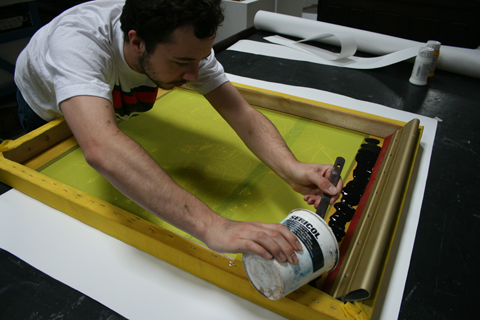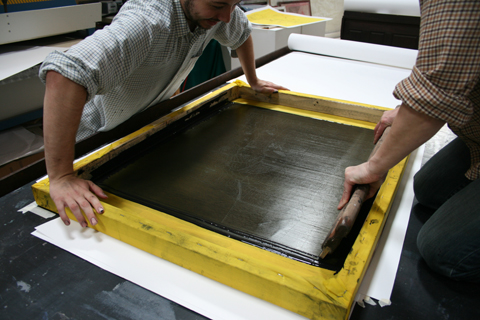Working as a print and dye technician for a number of years, means I've coated a lot of screens, I know many of the things that can go wrong and (usually) how to avoid them.
There are a lot of different screen emulsions on the market. I use Folascreen DC - 200 which I've found to be a very good emulsion - it doesn't break down on the screen during use but comes off easily when you want to get it off the screen to re-expose another image. Screen emulsion comes in two parts - the emulsion itself which is a viscous fluid, and a sensitiser, which is a powder. The sensitiser is chrome based and harmful - so care must be taken when handling this product.
Its worth knowing that the emulsion, which has a shelf life of about a year un-mixed, once it's been mixed with the sensitiser, only has a shelf life of between 4-6 weeks.
The sensitiser is dissolved in a small quantity of warm water and this is then added carefully and thoroughly to the emulsion. However carefully you do this it is impossible not to bring some air bubbles into the mixture and so once the emulsion is mixed it's best to leave it to rest for a few hours before coating a screen during which time the air bubbles will usually disperse (pop any on the surface which haven't).
First make sure your screen is clean and free of grease. Old screens can get quite stained with stencil images - there are a number of stencil removers on the market to clear this. I don't usually find it a problem. It's important that the screen is free of grease or the emulsion will not adhere properly and the coating will have a lot of pin holes - again there are a number of screen de-greasing products on the market, but hot water and washing-up liquid works fairly well on a less industrial level of printing.
I have always used
Screenstretch for my screens, coating troughs and ancillary screen products.
Coating troughs have removable ends, as long as these are cleaned well after use, they will fit tightly to the ends of the trough so theres no leakage when the emulsion is poured into the trough.
They come in different lengths. While it's possible to coat a screen using a small trough by overlapping the emulsion - it's preferable to have a variety of length troughs for different sized screens - and select a trough to fits the screen that you're coating.
In order to coat the screen with an even coverage of emulsion - choose a coating tough that fits inside the frame of your screen.
Sensitised screen emulsion is affected by light and will start to harden on the screen if exposed to daylight, so preferably coat your screen in low or safe light. If this is impossible, then coat them quickly and move to a dark place as soon as they are coated.
Pour more emulsion than you need into the coating trough to ensure you have enough to coat the screen.
The coating trough ends have a flat fronted edge. Tip the trough towards the mesh until the emulsion is touching the mesh evenly along the edge of the trough and the flat edge is pressed against the mesh. I use a plank of wood behind the screen (as you can see in the photos) to create a slight angle from the vertical which prevents the screen tipping forward or moving backward during coating.
Pressing firmly and evenly against the mesh with the flat ends of the trough, pull the trough up steadily from the bottom of the screen to the top. One pull is usually enough but if your screen does not coat successfully the first time, re-coat it by going through exactly the same process again. Some emulsions require coating the screen on the back as well as the front, I only coat the front of the screen and have normally found this to be sufficient.
Too much or uneven emulsion on the screen can cause exposure problems. You can often correct a badly coated screen by pulling the trough against the mesh again, tipped backwards away from the mesh (dry coating) to remove the excess emulsion on the screen. This may need to be done on the inside as well as the outside of the mesh.
Dry your screen in the dark and preferably horizontally to avoid drips running down the emulsion. I have to dry my screens vertically in my darkroom as I don't have a horizontal drying system. I use a fan heater to dry them quickly and it has rarely caused any problems, providing I've ensured that there's no excess emulsion on the screen first.
Here, a perfectly coated screen ready to be exposed!




































